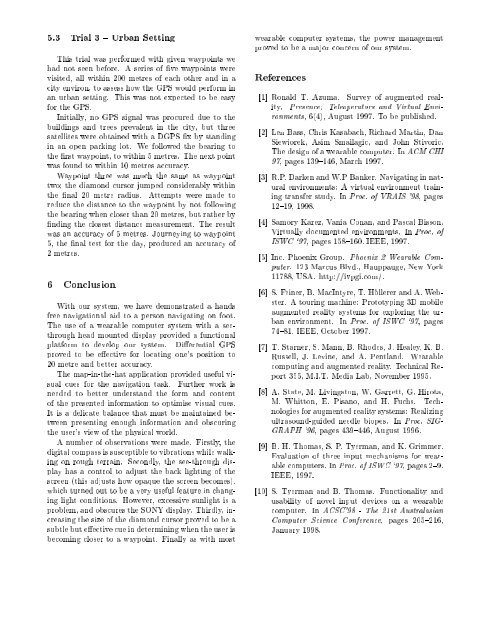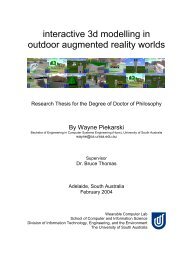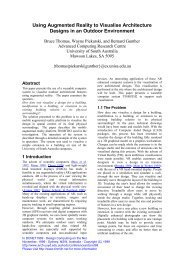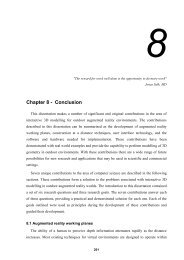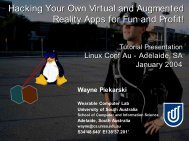A Wearable Computer System with Augmented Reality to Support ...
A Wearable Computer System with Augmented Reality to Support ...
A Wearable Computer System with Augmented Reality to Support ...
You also want an ePaper? Increase the reach of your titles
YUMPU automatically turns print PDFs into web optimized ePapers that Google loves.
5.3 Trial 3 { Urban SettingThis trial was performed <strong>with</strong> given waypoints wehad not seen before. A series of ve waypoints werevisited, all <strong>with</strong>in 200 metres of each other and in acity environ, <strong>to</strong> assess how the GPS would perform inan urban setting. This was not expected <strong>to</strong> be easyfor the GPS.Initially, no GPS signal was procured due <strong>to</strong> thebuildings and trees prevalent in the city, but threesatellites were obtained <strong>with</strong> a DGPS x by standingin an open parking lot. We followed the bearing <strong>to</strong>the rst waypoint, <strong>to</strong> <strong>with</strong>in 5 metres. The next pointwas found <strong>to</strong> <strong>with</strong>in 10 metres accuracy.Waypoint three was much the same as waypointtwo the diamond cursor jumped considerably <strong>with</strong>inthe nal 20 metre radius. Attempts were made <strong>to</strong>reduce the distance <strong>to</strong> the waypoint by not followingthe bearing when closer than 20 metres, but rather bynding the closest distance measurement. The resultwas an accuracy of 5 metres. Journeying <strong>to</strong> waypoint5, the nal test for the day, produced an accuracy of2 metres.6 ConclusionWith our system, we have demonstrated a handsfree navigational aid <strong>to</strong> a person navigating on foot.The use of a wearable computer system <strong>with</strong> a seethroughhead mounted display provided a functionalplatform <strong>to</strong> develop our system. Dierential GPSproved <strong>to</strong> be eective for locating one's position <strong>to</strong>20 metre and better accuracy.The map-in-the-hat application provided useful visualcues for the navigation task. Further work isneeded <strong>to</strong> better understand the form and conten<strong>to</strong>f the presented information <strong>to</strong> optimise visual cues.It is a delicate balance that must be maintained betweenpresenting enough information and obscuringthe user's view of the physical world.Anumber of observations were made. Firstly, thedigital compass is susceptible <strong>to</strong> vibrations while walkingon rough terrain. Secondly, the see-through displayhas a control <strong>to</strong> adjust the back lighting of thescreen (this adjusts how opaque the screen becomes).which turned out <strong>to</strong> be a very useful feature in changinglight conditions. However, excessive sunlight isaproblem, and obscures the SONY display. Thirdly, increasingthe size of the diamond cursor proved <strong>to</strong> be asubtle but eective cue in determining when the user isbecoming closer <strong>to</strong> a waypoint. Finally as <strong>with</strong> mostwearable computer systems, the power managementproved <strong>to</strong> be a major concern of our system.References[1] Ronald T. Azuma. Survey of augmented reality.Presence: Teleopera<strong>to</strong>rs and Virtual Environments,6(4), August 1997. To be published.[2] Len Bass, Chris Kasabach, Richard Martin, DanSiewiorek, Asim Smailagic, and John Stivoric.The design of a wearable computer. In ACM CHI97, pages 139{146, March 1997.[3] R.P. Darken and W.P Banker. Navigating in naturalenvironments: A virtual environment trainingtransfer study. In Proc. of VRAIS '98, pages12{19, 1998.[4] Samory Karez, Vania Conan, and Pascal Bisson.Virtually documented environments. In Proc. ofISWC `97, pages 158{160. IEEE, 1997.[5] Inc. Phoenix Group. Phoenix 2 <strong>Wearable</strong> <strong>Computer</strong>.123 Marcus Blvd., Hauppauge, New York11788, USA. http://ivpgi.com/.[6] S. Feiner, B. MacIntyre, T. Hollerer and A. Webster.A <strong>to</strong>uring machine: Pro<strong>to</strong>typing 3D mobileaugmented reality systems for exploring the urbanenvironment. In Proc. of ISWC `97, pages74{81. IEEE, Oc<strong>to</strong>ber 1997.[7] T. Starner, S. Mann, B. Rhodes, J. Healey, K.B.Russell, J. Levine, and A. Pentland. <strong>Wearable</strong>computing and augmented reality. Technical Report355, M.I.T. Media Lab, November 1995.[8] A. State, M. Livings<strong>to</strong>n, W. Garrett, G. Hirota,M. Whit<strong>to</strong>n, E. Pisano, and H. Fuchs. Technologiesfor augmented reality systems: Realizingultrasound-guided needle biopes. In Proc. SIG-GRAPH `96, pages 439{446, August 1996.[9] B. H. Thomas, S. P. Tyerman, and K. Grimmer.Evaluation of three input mechanisms for wearablecomputers. In Proc. of ISWC `97, pages 2{9.IEEE, 1997.[10] S. Tyerman and B. Thomas. Functionality andusability of novel input devices on a wearablecomputer. In ACSC'98 - The 21st Australasian<strong>Computer</strong> Science Conference, pages 205{216,January 1998.


